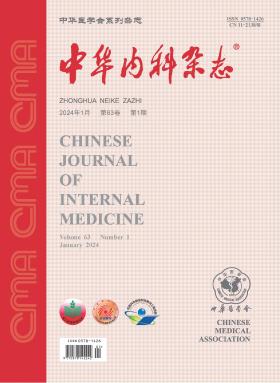[阻塞性肺通气功能障碍患者的脉冲振荡测量系统指数与常规肺功能测试的相关性]。
摘要
目的研究脉冲振荡测量系统检查指标与常规肺通气功能之间的相关性。方法:纳入华中科技大学同济医学院附属同济医院 2020 年 1 月 1 日至 2022 年 12 月 31 日 10 883 例患者的肺通气功能数据。对照组(3 478 人)和阻塞组(7 405 人)的一秒率[第一秒用力呼气容积(FEV1)与用力肺活量(FVC)之比]占预测值的百分比≥92%。根据肺功能障碍程度将阻塞组细分为五组:轻度组(n=3 938)、中度组(n=1 142)、中重度组(n=917)、重度组(n=737)和极重度组(n=671)。两组患者均检测了常规肺通气功能 FVC、FEV1、一秒钟速率、50% FVC 时的强迫呼气流量(MEF50%)、75% FVC 时的强迫呼气流量(MEF25%)、最大呼气中流量(MMEF)、呼气峰值流量(PEF)和脉冲振荡肺功能测试。5 赫兹阻抗(Z5)表示总呼吸阻力,5 赫兹阻力(R5)表示总气道阻力,5 赫兹反应(X5)表示外周气道的弹性反冲,20 赫兹阻力(R20)表示中央气道的阻力。R5-R20 反映了小气道的阻力。此外,还测量了外周阻力(Rp)、呼吸共振频率(Frex)和反应曲线下面积(Ax)。分析了两组指标之间的相关性以及脉冲振荡测量系统参数对阻塞性肺通气功能障碍诊断的敏感性和特异性。结果肺功能第一秒用力呼气容积占预测值的百分比(FEV1%Pre)[80.10 (54.95,97.10)%], 一秒钟速率[62.43(48.67,67.02)%], MEF50% [1.33 (0. 62,1.97)L/s], MEF50% [1.33 (0. 62,1.97)L/s].62,1.97)L/s]、MEF25%[0.28(0.17,0.41)L/s]、MMEF[0.85(0.43,1.29)L/s]和PEF[5.64(3.73,7.50)]L/s均显著低于对照组(P0.05)。阻塞组各亚组间的差异也很明显(P0.05)。脉冲振荡 Z5 [0.42 (0.33,0.55)kPa-L-1-s-1],Rp [0.25 (0.20,0.45)kPa-L-1-s-1], R5 [0.39 (0.31,0.49)kPa-L-1-s-1], R20 [0.28 (0.24,0.34)kPa-L-1-s-1], R5-R20 [0.09(0.05,0.17)kPa-L-1-s-1]、Frex[16.32(13.07,20.84)Hz]和 Ax[0.67(0.28,1.64)]指数均显著高于对照组。X5 [-0.14 (-0.23, -0.10)kPa-L-1-s-1]明显低于对照组(P0.05)。阻塞组不同阻塞程度之间的 Z5、Rp、X5、R5、R5-R20、Frex 和 Ax 均有统计学意义(P0.05)。脉冲振荡系统参数 Z5、Rp、R5、R20、R5-20、Frex 和 Ax 与常规肺通气指数呈负相关(r=-0.21-0.68,P0.05),参数 X5 与常规肺通气指数呈正相关(r=0.41-0.68,P0.05)。脉冲振荡肺功能测试参数 X5(58.60%-95.68%)和 Ax(57.08%-98.06%)的敏感性最好;X5(86.29%-98.82%)、Frex(86.69%-94.71%)和 Ax(88.10%-98.53%)的特异性最好;R20 的敏感性和特异性最差。女性患者的敏感性和特异性略好于男性患者。结论脉冲振荡测量系统的技术参数与常规肺通气功能检测的相关指标有显著相关性。这些指标能很好地反映不同程度的肺通气功能变化,对评估肺功能损伤程度具有较大的参考意义。Objective: To investigate the correlation between impulse oscillometry system examination indicators and conventional pulmonary ventilation function. Methods: The pulmonary ventilation function data of 10 883 patients from January 1, 2020 to December 31, 2022 at Tongji Hospital, Tongji Medical College, Huazhong University of Science and Technology were included. The one-second rate [ratio of forced expiratory volume in the first second (FEV1) to forced vital capacity (FVC)] measured as a percentage of the predicted value was ≥92% for the control group (n=3 478) and <92% for the pulmonary obstruction group (n=7 405). The obstruction group was subdivided into five groups according to the degree of pulmonary dysfunction: mild group (n=3 938),moderate group (n=1 142),oderate-severe group (n=917),severe group (n=737),and extremely severe group (n=671). Conventional pulmonary ventilatory function FVC, FEV1, one-second rate, and forced expired flow at 50% of FVC (MEF50%), forced expired flow at 75% FVC (MEF25%), maximal mid-expiratory flow (MMEF), peak expiratory flow (PEF), and pulsed oscillation pulmonary function test were detected in both groups of patients. Impedance at 5 Hz (Z5) means total respiratory resistance, resistance at 5 Hz (R5) means total airway resistance, reactance at 5 Hz (X5) indicates the elastic recoil of the peripheral airways, and resistance at 20 Hz (R20) represents resistance of the central airways. R5-R20 reflects resistance in the small airways. Additionally, peripheral resistance (Rp), respiratory resonance frequency (Frex), and area under the reactance curve (Ax) were also measured. Correlation between the indicators of the two groups and the sensitivity and specificity of the impulse oscillometry system parameters for the diagnosis of obstructive pulmonary ventilation dysfunction were analyzed. Results: Pulmonary function force expiratory volume in the first second as a percentage of predicted value (FEV1%Pre) [80.10 (54.95,97.10)%],one-second rate [62.43(48.67, 67.02)%],MEF50% [1.33 (0.62,1.97)L/s],MEF25% [0.28 (0.17,0.41)L/s], MMEF [0.85 (0.43,1.29)L/s],and PEF [5.64 (3.73,7.50)]L/s in the obstruction group were significantly lower than those in the control group (P<0.05). The differences within the subgroups of the obstruction group were also significant (P<0.05). Pulsed oscillation Z5 [0.42 (0.33,0.55)kPa·L-1·s-1],Rp [0.25 (0.20,0.45)kPa·L-1·s-1], R5 [0.39 (0.31,0.49)kPa·L-1·s-1], R20 [0.28 (0.24,0.34)kPa·L-1·s-1], R5-R20 [0.09 (0.05,0.17)kPa·L-1·s-1],Frex [16.32 (13.07,20.84)Hz], and Ax [0.67 (0.28,1.64)] indices in the obstruction group were significantly higher than those in the control group. X5 [-0.14 (-0.23, -0.10)kPa·L-1·s-1] was significantly lower than that in the control group (P<0.05). Z5, Rp, X5, R5, R5-R20, Frex, and Ax were statistically significant between different degrees of obstruction in the obstruction group (P<0.05). The impulse oscillometry system parameters Z5, Rp, R5, R20, R5-20, Frex, and Ax were negatively correlated with the indices of conventional pulmonary ventilation (r=-0.21-0.68, P<0.05), and the parameter X5 was positively correlated with the indices of conventional pulmonary ventilation (r=0.41-0.68, P<0.05). The pulsed oscillation pulmonary function test parameters X5 (58.60%-95.68%) and Ax (57.08%-98.06%) presented the best sensitivity; X5 (86.29%-98.82%), Frex (86.69%-94.71%), and Ax (88.10%-98.53%) displayed the best specificity; and R20 presented the worst sensitivity and specificity. The sensitivity and specificity were slightly better in female patients than in male patients. Conclusion: The technical parameters of the impulse oscillometry system showed significant correlation with relevant indices of conventional pulmonary ventilation function detection. These well reflect the changes of different degrees of pulmonary ventilation function and have greater significance for reference in evaluating the degree of pulmonary function impairment.

 求助内容:
求助内容: 应助结果提醒方式:
应助结果提醒方式:


